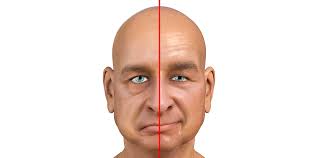Bell’s Palsy Facial Paralysis
What is Bell’s Palsy?
Bell’s Palsy is a condition where temporary facial paralysis occurs due to trauma or damage done to the nerves in the face, especially the Facial Nerve (the 7th Cranial Nerve). Various viruses and infections, including the Herpes Simplex virus, Chicken Pox, and Epstein-Barr (which causes mononucleosis) , as well as diabetes and high blood pressure can all affect the Facial Nerve.
This nerve travels through a canal in the skull and extends from just under each ear to the muscles that are located on either side of the face. The facial nerve controls the mouth (smiling, forming words, etc.), closing the eyelids or blinking, frowning, and similar movements. It also transmits nerve impulses to the saliva glands, tear glands, taste sensations, and the muscles of the stapes (a small bone located in the middle ear).
Bell’s Palsy affects the Facial Nerve by disrupting its function so that messages from the brain cannot reach the associated muscles. This results in facial paralysis or weakness, usually on one side of the face only.

There are no specific tests used to diagnose Bell palsy, but tests to rule out other conditions that can cause similar symptoms and to determine the extent of nerve involvement or damage.
These tests may include:
Electromyography – to determine the extent of the nerve involvement.
Blood tests- to determine if another condition, such as diabetes or Lyme disease, is present.
MRI or CT scan – to find out if there is a structural cause for your symptoms.
The condition affects a patient’s physical, social, and psychological health. It is important for the patient to recover quickly and minimize the risk of long-term sequelae. Therefore, researchers recommend a combination of several therapeutic modalities to shorten the disease.
How is Bell’s Palsy treated?
If a specific cause for Bell palsy is identified, such as infection, then that cause will be treated. Otherwise, the symptoms are treated as needed. One treatment usually advised is protecting the eye from drying at night or while working at a computer. Eye care may include eye drops during the day, ointment at bedtime, or a moisture chamber at night. This helps protect the cornea from being scratched. This is very important to manage Bell palsy.
Treatment for your condition is based on the severity of your symptoms and your health history. Therapies include:
- Steroids to reduce inflammation
- Antiviral medicine, such as Acyclovir
- Analgesics or moist heat to relieve pain
- Physical therapy to stimulate the Facial Nerve
- Relaxation/Massaging the face
- Facial Exercises
Chiropractors can provide the following treatments for Bell’s Palsy:
- Electrical stimulation (TENS)
- Biofeedback training
- Electro-Acupuncture

- Chiropractic Adjustments to the Upper Cervical
Vitamin therapy, including B-12, B-6, and the mineral Zinc may shorten the course and improve curative effects.
Bell palsy usually starts to improve in 2 weeks. But it may take 3 to 6 months to return to normal. Treatment will help with comfort and shorten the duration of the symptoms. Bell’s palsy usually resolves in time and causes no long-term complications.




